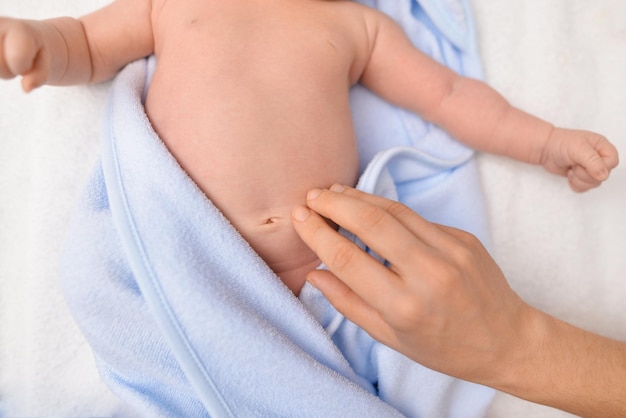Stumped on how to keep your baby’s belly button clean? Follow these steps on how to wash a baby’s belly button before and after the umbilical stump falls off.
Your baby’s umbilical cord is their lifeline during pregnancy, bringing them oxygen and nutrients through the placenta until the day they are born. Once born, that long cord is clamped and cut (unless you have a lotus birth). What’s left is a short stump that will eventually dry up and fall off, leaving behind an abdominal scar known as the belly button.
But how do you take care of this extra sensitive area? Read on to learn tips for how to clean a baby’s belly button both before and after the umbilical cord stump falls off.
How to Clean a Baby’s Umbilical Cord Stump
Before your baby’s umbilical cord stump falls off—which is usually some time between five to 15 days after birth—you’ll want to stick to sponge baths.
Experts once advised parents to clean the stump with rubbing alcohol at every diaper change during this time. But now, the American Academy of Pediatrics (AAP) recommends simply keeping the umbilical stump clean and dry. Here’s how.
1. Get prepared
Gather all the items you’ll need before you start cleaning (remember, never leave your baby unattended on an elevated surface or near water). To keep the cord stump from getting wet, give your newborn sponge baths before the cord falls off (usually within two weeks of birth).
Gather the following supplies:
- Large absorbent towel to lay your baby on
- Soft sponges or washcloths
- Cotton swabs
- A small bowl of warm water
- Baby soap or cleanser
Set your baby’s clean clothes and a new diaper within reach.
2. Wash your hands
Lather up before handling your baby’s umbilical cord. “Washing your own hands prevents the chance of spreading any germs that might cause infection,” says Mary Ann LoFrumento, MD, assistant professor of pediatrics and well baby nursery hospitalist at Columbia University.
3. Do a quick inspection
Look for signs of infection around the umbilical cord stump. Margaret Grell, MD, a pediatrician at Joe DiMaggio Children’s Hospital in Hollywood, Florida, says if you notice any of the following symptoms, call a health care provider immediately:
- Foul smell
- Discharge or pus around the umbilical cord
- Redness, tenderness, or swelling of the surrounding skin
- Continuous bleeding
- Fever
- Lethargy
- Poor feeding or irritability
You should never pull the stump off, even if it’s just hanging by a thread. Doing so could cause active bleeding.
4. Wipe down the cord
The umbilical cord must remain clean and dry until it falls off naturally. In the past, people used alcohol to clean umbilical cords. However, alcohol is no longer recommended because research shows that cords fall off sooner when allowed to dry naturally.
To clean the cord, follow these steps:
- Dip a cotton swab in warm water.
- Squeeze the tip to remove the excess water.
- Gently clean around the base of the cord and then the surrounding skin.
- Hold the stump with a clean, absorbent cloth to dry it thoroughly.
If there’s urine or poop in the cord area, it’s not a problem. Simply clean it with a cotton swab dipped in soapy, warm water, then dry the cord completely with a clean, absorbent cloth. Also, cleanse the surrounding skin, says Dr. Grell.
4. Dry the cord
Hold a clean, dry washcloth over the area gently, or use a piece of paper to fan it dry. Don’t cover the stump when you put on your baby’s diaper. Instead, fold the front of the diaper down or use one with a cutout for the umbilical cord.
5. Skip the extras
Don’t use lotion, powder, or oils on or around your baby’s umbilical cord. They are unnecessary and can possibly cause infection, says Dr. LoFrumento.

How to Clean a Baby’s Belly Button
Once the umbilical cord falls off, you can begin to bathe your baby in a shallow baby tub of lukewarm water. Simply clean the belly button area with soap and water like you do the rest of your baby’s body.
Gather your cleaning materials
Your baby is probably getting real and regular baths now, so gather the following:
- Soft washcloth
- Mild baby soap or cleanser
- Towel for drying
Fill the sink or baby tub with 2 to 3 inches of warm water. The American Academy of Dermatology Association suggests testing the temperature of the water on the inside of your wrist to ensure it’s not too warm. Then, gently glide your baby into the water feet-first.
Wash your hands
Even though the belly button is less likely to get infected at this point, it’s still a good idea to wash your hands before and after tending to your baby’s hygiene.
Wipe the belly area
Clean your baby’s belly button after washing their face, eyes, hair, and upper body. Take the washcloth, gently wipe in and around the belly button, rinse the area, and then finish the bath, says Dr. LoFrumento.
The AAP advises keeping bath times short—no more than 10 minutes. This will help prevent your baby’s delicate skin from drying out.
Dry the belly button
Dry the belly button like you dry the other parts of your baby’s body. Use a clean, dry towel and gently pat it on the area, thoroughly drying the inside of the belly button if your baby has an innie.
Moisturize the belly
Using baby lotion around the belly area is fine after the navel heals. But apply the cream lightly and steer clear of using any adult products that might irritate your baby’s sensitive skin.
